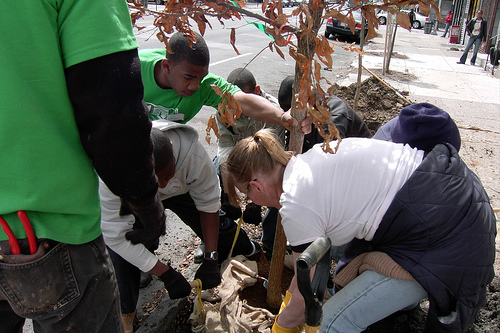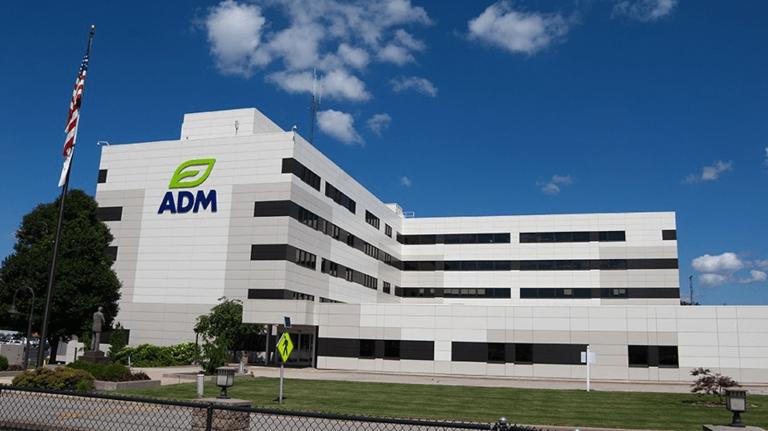
Planting trees in West Philly. (Photo by Danielle Clarke.)
One Saturday in November, a few hundred volunteers descended upon parks and creek banks in and around Philadelphia to plant more than 2,000 trees. That day’s plantings were just a piece of a broader initiative to plant 300,000 trees in the City of Brotherly Love by 2015. And that initiative is but one part of a much larger program spearheaded by the Pennsylvania Horticultural Society that aims to plug 1 million trees into the ground across 13 counties in southeastern Pennsylvania, New Jersey, and Delaware. The mid-Atlantic is seriously putting the moves on Mother Nature.
As cities around the country jockey to be the King of Green, mayors and community organizations have been eager to claim their place as the next urban Johnny Appleseed. (Upon becoming mayor in 2008, Philadelphia Mayor Michael Nutter declared the city would become the greenest in America, and established an office of sustainability to show everyone he meant business.) But despite all the work days and feel-good volunteerism, urban forests are losing ground, in part because many, if not most, trees planted in cities die early deaths.
“Trees are so essential to our life, health, and safety,” says Caryn Bosson, a communications manager for the Los Angeles-based TreePeople, founded in 1973 for the express purpose of using trees to make cities more sustainable. Just one tree planted near a home has the potential to reduce heating and cooling costs by as much as $2,500.
If you can keep the tree alive, that is. “The planting of trees is a sexy thing to do — people want to plant trees,” say Ryan Allen, TreePeople’s tree care manager. “Getting them to come back within five years is tricky.”
That first five years is perhaps the most crucial part of a tree’s lifespan. A variety of factors can kill off an urban tree relatively quickly: Transplant shock to the roots of trees dug up at nurseries leaves trees susceptible to insects and disease; damaged tree roots, often the result of transplanting, can result in water stress where a tree loses water at a faster rate than it absorbs water. For city trees, vehicle traffic, air pollution, and street design can make healthy growth even more difficult. A report published in the journal Cities and the Environment [PDF] two years ago estimated that between 34 and 99 percent of young trees die off within the first five years.
A study published early this year by the journal Urban Forestry & Urban Greening [PDF] showed that tree cover across the country is declining by roughly 4 million trees each year. Of the 20 cities studied by the U.S. Forest Service, 17 had experienced net losses in tree cover, while 16 saw net gains in impervious cover — pavement, rooftops, and anything else that doesn’t allow rain to seep into the soil.
To stop this backsliding, organizations like TreePeople are trying to get volunteers to care for trees after the planting festivities are over. But that’s the unsexy part of urban tree planting. It’s far easier to get people to come out to plant if you have a gaggle of cheerleaders in tow, or if tree planting culminates in a huge event, like when the NFL planted thousands of Floridian mangroves in anticipation of the 2007 Super Bowl in Miami.
How do we make urban tree plantings more than mascot-filled publicity stunts?
“Our starting point around any involvement with trees is to start with the stewardship,” says Maitreyi Roy, the senior vice president of programs and planning with the Pennsylvania Horticultural Society (PHS). Before trees are even planted, she says, people are taught what it takes to keep trees alive. To that effect, the PHS has some 3,600 Tree Tenders, 2,500 in Philadelphia alone, who not only make annual checks of trees, but also teach volunteers about watering, pruning, and other tree-care techniques. Last year, Tree Tenders trained city staff and created a Tree Team for continuing tree maintenance in city parks. Also in use is a texting system that blasts volunteers with information on when to water trees in drought conditions.
“The goal here is to create a decentralized system so that the drive at the grassroots [level] fuels stewardship on an ongoing basis,” Roy says.
At L.A.-based TreePeople, community tree care teams serve a similar role. They educate volunteers, organized into Green Teams, on how to water, prune, and mulch trees, and then demonstrate at sites around the cities before helping Green Teams develop a maintenance plan according to a tree care checklist — pruning, watering, weeding, removing stakes and ties, and so on — specifically created for planting volunteers. In July, TreePeople kicks off its citizen arborist program, which will offer six weeks of “really in-depth education and planning,” Allen says, and is based on the International Society of Arboriculture’s certification program.
In the end, however, the simple trick to taking care of urban trees might be removing the gimmicks from tree planting altogether: Don’t let tree planters wash their hands of the whole affair after a few hours of work on a weekend afternoon. Allen suggests a solution, one that guides TreePeople’s involvement with the urban forest: “We’re not going to plant trees with you — schools, companies — if you’re not going to make the commitment to take care of the trees afterwards.”



